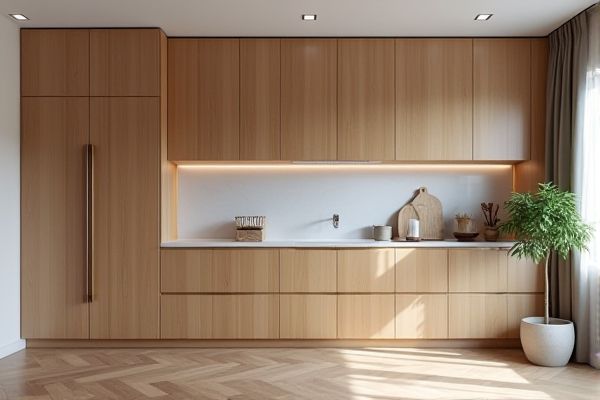
Narrow cabinets maximize space in small or tight areas, offering focused storage without overwhelming the room, while wide cabinets provide extensive storage and easier access to items, ideal for larger spaces. Explore the rest of this article to determine which cabinet type best suits your organization needs and enhances Your space efficiently.
Table of Comparison
| Feature | Narrow Cabinet | Wide Cabinet |
|---|---|---|
| Width | Typically 12-18 inches | Typically 24-48 inches |
| Storage Capacity | Limited, ideal for small items | Ample, suited for large or multiple items |
| Space Efficiency | Best for tight or narrow spaces | Requires more floor or wall space |
| Installation Locations | Hallways, corners, small kitchens | Kitchens, closets, utility rooms |
| Price | Generally lower cost | Higher cost due to size |
| Accessibility | Easier access in compact areas | Better organization with wider shelves |
Introduction to Narrow vs Wide Cabinets
Narrow cabinets, typically ranging from 9 to 15 inches in width, offer space-saving solutions ideal for small kitchens or tight spaces, maximizing vertical storage without overcrowding the area. Wide cabinets, often 30 inches or more, provide ample storage capacity suited for larger kitchens, allowing for organization of bulky items and easy access. Choosing between narrow and wide cabinets depends on kitchen size, storage needs, and functional flow requirements.
Space Efficiency: Narrow Cabinets
Narrow cabinets maximize space efficiency by fitting into tight or awkward areas, making them ideal for small kitchens or bathrooms with limited wall space. They provide organized storage for utensils, spices, or toiletries without occupying much floor area, optimizing vertical space utilization. Compared to wide cabinets, narrow options reduce clutter and improve accessibility by keeping items more visible and within easy reach.
Storage Capacity: Wide Cabinets
Wide cabinets offer significantly greater storage capacity compared to narrow cabinets, providing ample space for bulky items and larger collections. Their increased width allows for multiple shelves and compartments, maximizing organization and accessibility. You benefit from the ability to store more items efficiently without overcrowding.
Aesthetics and Design Impact
Narrow cabinets offer a sleek, minimalist aesthetic that enhances vertical lines and maximizes space in compact areas, making them ideal for modern or small-scale designs. Wide cabinets create a bold statement with a broader visual footprint, providing a balanced, substantial look ideal for kitchens or rooms that need ample storage while maintaining style. Your choice impacts the room's flow and perception of space, as narrow units promote openness while wide cabinets contribute to a more grounded and organized environment.
Functional Differences in Daily Use
Narrow cabinets maximize space in tight areas, making them ideal for storing smaller items or creating vertical storage solutions in your kitchen or bathroom. Wide cabinets offer greater capacity and easier access to larger items, reducing clutter and improving organization in frequently used spaces. Choosing between narrow or wide cabinets depends on your storage needs, room layout, and how you prioritize accessibility versus space efficiency.
Best Room Applications for Each Type
Narrow cabinets are ideal for small or tight spaces such as hallways, bathrooms, or beside appliances where maximizing vertical storage without consuming much floor area is essential. Wide cabinets work best in kitchens, living rooms, or dining areas where you need extensive storage and countertop space for food preparation or decorative displays. You can optimize your room's functionality by selecting narrow cabinets for compact spaces and wide cabinets for areas requiring broad storage solutions.
Customization Options
Narrow cabinets offer greater flexibility in tight spaces, allowing you to customize shelving heights and door styles to maximize storage efficiency. Wide cabinets provide expansive interior configurations, ideal for storing larger items and incorporating features like pull-out trays, built-in organizers, or adjustable dividers. Choosing between narrow and wide cabinets depends on your specific storage needs and the level of customization required for your space.
Cost Comparison
Narrow cabinets typically cost less than wide cabinets due to lower material use and simpler installation requirements, making them a budget-friendly choice for compact spaces. Wide cabinets, while more expensive, offer greater storage capacity and better organization, potentially reducing the need for additional furniture. When planning your space, consider how cost variations impact your overall budget and storage needs.
Maintenance and Longevity
Narrow cabinets typically require less maintenance due to fewer surface areas that can accumulate dust or grime, making them easier to clean regularly. Wide cabinets, while offering more storage space, may demand more attention to prevent wear and tear, especially on hinges and shelves subjected to heavier use. Your choice between narrow or wide cabinet affects not only organization but also the effort needed to maintain its appearance and ensure long-term durability.
Choosing the Right Cabinet for Your Space
Narrow cabinets maximize storage in tight or limited spaces, making them ideal for small kitchens or bathrooms, while wide cabinets offer more extensive storage and better accessibility for larger rooms. Your choice should consider available space, storage needs, and the design flow of your area to ensure functionality without crowding. Selecting the right cabinet impacts both the organization and aesthetic of your living space.
 homyna.com
homyna.com